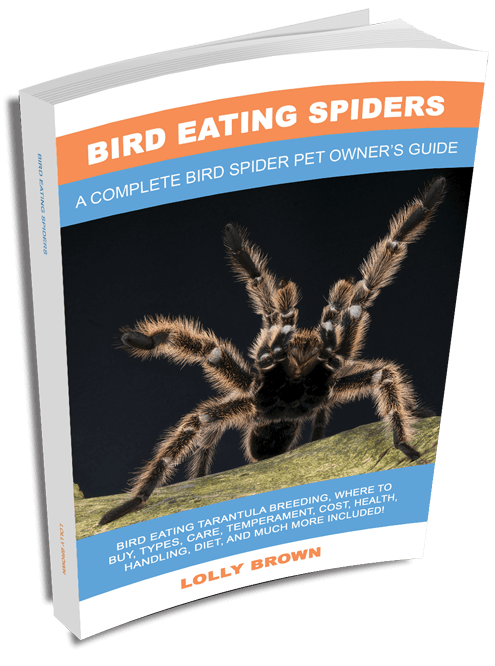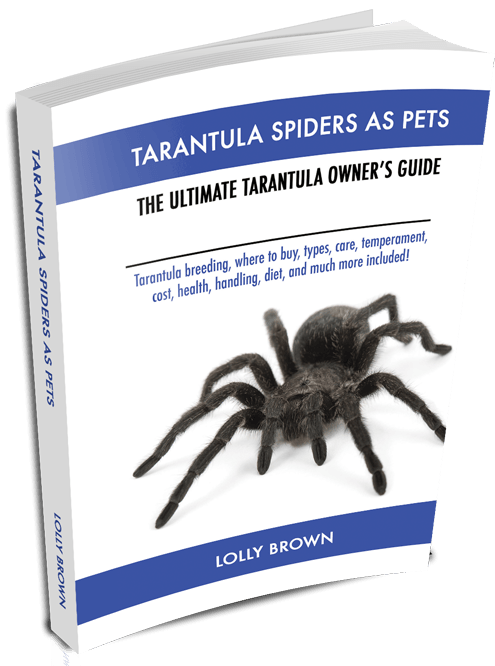Bird Eating Spiders
Bird Eating Tarantula breeding, where to buy, types, care, temperament, cost, health, handling, diet, and much more included!

120
PAGES
10
CHAPTERS
46+
SALES
OVERVIEW
List of chapters included in the book
Chapter 1
Biological Information of Bird Eating Spiders
Chapter 2
Bird Eating Spiders as Pets
Chapter 3
How to Acquire a Bird Eating Spider
Chapter 4
Habitat Set Up for Your Bird Eating Spider
Chapter 5
Bird Eating Spiders Handling and Behavior
Chapter 6
Feeding Your Bird Eating Spiders
Chapter 7
Breeding Your Bird Eating Spiders
Chapter 8
Raising Bird Eating Slings
Chapter 9
The Spider Molting Process
Chapter 10
Summary and Care Sheet
READ IT IN ALL DEVICES
or in physical paperback


Bird Eating Spiders Ultimate Pet Guide
Bird eating spiders are one of the largest and scariest of all the spider species under the tarantula family. They are big and they can also bite, but they’re not dangerous to humans. This creature is not meant to be kept as pets for the faint of heart but if you want to turn fear into fascination, then you’ll need this book to set aside the fangs and get on with the facts! Find out more about the Bird Eating Spider in this book and learn what it would take for you to acquire one, keep one in your home, feed it, and how you can enjoy caring for it in captivity. Learn more about this goliath sized arachnid to help you make a decision if this is the right hairy species for you and your family. Get ready to put your fangs on!
Bird Eating Tarantula breeding, where to buy, types, care, temperament, cost, health, handling, diet, and much more included!
ABOUT THE AUTHOR
A life-long animal lover, Lolly Brown is equally comfortable writing about exotic creatures like the Mexican axolotl or dispensing practical advice to dog owners about kennel cough. As a child, Brown first learned about fish and aquaria when her father brought home a 10-gallon aquarium as a surprise for his daughter. Within months, the father-daughter team graduated to a 120-gallon tank and were immersed in the intricacies of tank population management. “We had that go-big-or-go-home mentality common to the hobby,” Brown said. “Now I look back and think about what we did to Mama’s living room! She was very patient with us.”
Brown’s fascination with animals continued in college, where she took numerous field biology and wildlife classes that allowed her to view the behavior of many species in their native habitats. She calls this period of her life the “rodent years,” since her only apartment roommates were two hamsters, Hemingway and Leo (Tolstoy). “I also adopted a Guinea pig purely because I couldn’t stand the conditions in the pet store,” she said. “Trust me, I was in no way prepared to care for Molly and I had to learn fast!”

“The only other time I went into a pet adoption blind,” Brown added, “I came home with two green anole lizards. Then I found out I was going to have to feed them live crickets. While volunteering at her local zoo, Brown first encountered capybaras, a South American mammal that looks like an over-sized Guinea pig. The experience sparked her interest in exotic pets, a subject she continues to pursue with avid interest. A freelance writer by trade, Brown’s animal books are written for her own pleasure and the edification of her readers. She is a strong supporter of animal rescue and welfare organizations, and works with programs educating young children about the proper care of pets. Brown maintains something of a menagerie of her own, making room in her home for a 180-gallon saltwater fish tank, a 20-year old Scarlet Macaw, a Golden Retriever, and several highly tolerant cats. (She advises that good cages make good multi-species homes.)
“If I become interested in a particular animal and have no direct experience with the creature, I get some before I start to write,” Brown says. “All animals have a unique perspective on the world and their place in it. They all have particular needs — physical and emotional — and they all have unique personalities. These are things I want to understand before I try to communicate them to my readers.”
Lolly Brown
WHAT READERS SAY
✭✭✭✭✭
An informative read!
An informative read. Helpful for many aspects of keeping this pet.
– Amazon Customer
OTHER BOOKS

Tarantula spiders
Tarantula breeding, where to buy, types, care, temperament, cost, health, handling, diet, and much more included!
COMING SOON!
Available Soon
Barking Spiders
The name barking spider can be misleading as these species of spider does not bark at all! What it does is create is a hissing sound, which they emit when provoked. The hissing sound is produced by the barking spider’s rubbing a patch of bristle around its mouthparts. They have heftier looking front legs which come in handy when they hunt and feed. Find out more about the barking spider in this book and learn what it would take for you to acquire one, incorporate one into your home, and how to take care of it while in captivity. Learn more about this very much in demand arachnid as this book introduces the barking spider and its equally popular cousins to help you make a decision on which hairy creature would suit you best.

“The Ultimate Pet Guide For Bird Eating Spiders”
